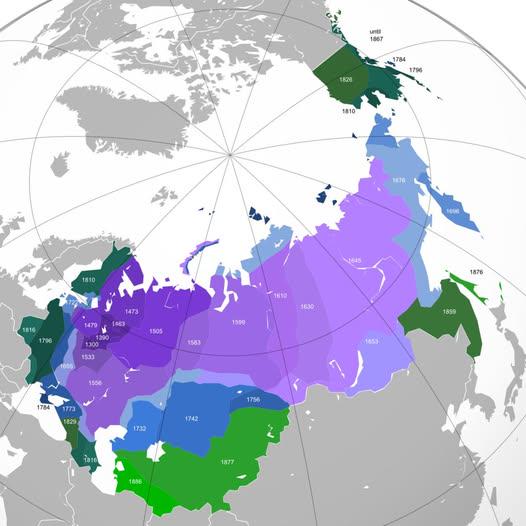Territorial Expansion of Russia Over Time Map


Alex Cartwright
Senior Cartographer & GIS Specialist
Alex Cartwright is a renowned cartographer and geographic information systems specialist with over 15 years of experience in spatial analysis and data...
Geographic Analysis
What This Map Shows
The "Territorial Expansion of Russia Over Time" map visualizes the dramatic changes in Russia's land boundaries from its inception to the present day. It highlights key periods of territorial acquisition, including significant events like wars, treaties, and colonization that contributed to establishing Russia as one of the largest countries in the world. This map serves as a visual representation of how a vast expanse of land has been shaped through a complex history of expansionism and geopolitical maneuvers.
Deep Dive into Russia's Territorial Expansion
Russia's territorial expansion is a fascinating yet complex narrative that reflects the country’s historical ambitions and geopolitical strategies. Ever wondered how Russia grew from a small principality in the 9th century to a colossal nation covering over 17 million square kilometers? The answer lies in a series of strategic conquests and political decisions spanning centuries.
The early expansion began with the Kievan Rus’, the precursor to modern Russia, which expanded through a combination of military conquests and alliances. By the 15th century, the Grand Duchy of Moscow emerged as a dominant force, gradually annexing surrounding territories. This period saw the unification of various Russian principalities under a single crown, which laid the groundwork for future expansion.
However, it was during the reign of Ivan III, known as Ivan the Great, that Russia began to significantly expand its borders. He successfully liberated Russian lands from Mongol rule and initiated a series of campaigns against neighboring states, thus increasing Moscow's influence.
The 17th century marked another pivotal moment with the Time of Troubles, leading to the establishment of the Romanov dynasty. The Romanovs expanded Russia’s territories through military campaigns and colonization, notably in Siberia. Interestingly, Siberia was not only annexed for its resources but also as a strategic buffer against potential invasions from the east. By the late 19th century, Russia had established itself in regions such as Alaska and parts of Central Asia, driven by both imperial ambitions and the need for new resources.
The 20th century brought significant changes with the aftermath of World War I and the Russian Revolution. The Treaty of Brest-Litovsk in 1918 resulted in significant territorial losses, but the subsequent establishment of the Soviet Union allowed for a reassertion of control over many of these regions. The USSR's expansion included the Baltic States, parts of Finland, and territories in Eastern Europe, showcasing a blend of ideological motivation and strategic interests.
After the dissolution of the Soviet Union in 1991, Russia faced a loss of territory but has since sought to reassert its influence over former Soviet states, particularly in regions like Crimea. The 2014 annexation of Crimea is a contemporary example of how historical claims and modern geopolitical strategies are intertwined.
Regional Analysis
When examining the territorial expansion of Russia by region, the differences in historical context and geopolitical significance become evident. For instance, the Siberian expansion was largely driven by resource acquisition, while the annexation of Crimea stemmed from strategic military and cultural interests.
In the Far East, regions like Sakhalin and the Kuril Islands were pivotal during the Russo-Japanese War, which highlighted Russia's ambitions in the Asia-Pacific region. Conversely, in the Caucasus, Russia's annexation of territories has often been met with resistance, signifying the complexities of ethnic identities and historical grievances.
Western territories, particularly those in Eastern Europe, have seen fluctuating control, especially during the 20th century. The Baltic states of Estonia, Latvia, and Lithuania highlight a region that has oscillated between Russian and European influences, demonstrating the ongoing struggle between national sovereignty and historical ties.
Significance and Impact
Understanding the territorial expansion of Russia is critical not only for historical knowledge but also for comprehending current geopolitical dynamics. The legacy of expansionism continues to affect relations with neighboring countries and has implications for global security. The ongoing tensions in Ukraine and the Arctic region are prime examples of how past territorial claims influence present-day conflicts.
Moreover, as Russia navigates its role on the world stage, the impact of its historical territorial ambitions shapes its foreign policy decisions. Current trends such as military deployments, economic sanctions, and energy politics are all intertwined with this expansive history. Looking ahead, the dynamics of Russia's borders will likely continue to evolve, influenced by both internal politics and external pressures.
In conclusion, the "Territorial Expansion of Russia Over Time" map not only serves as a historical record but also as a lens through which we can analyze contemporary issues facing Russia and its neighbors. Understanding this complex narrative is essential for grasping the intricacies of modern geopolitical relations and the enduring impact of history on present-day borders.
Visualization Details
- Published
- October 29, 2025
- Views
- 8
Comments
Loading comments...